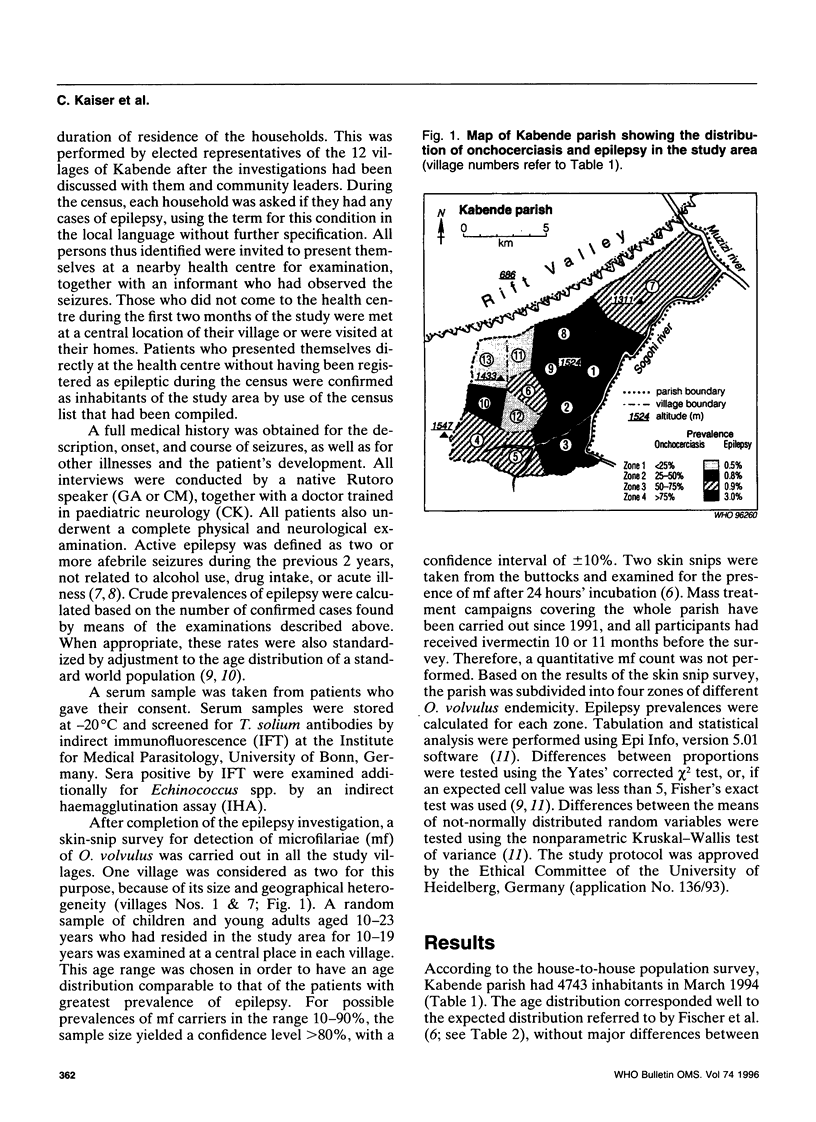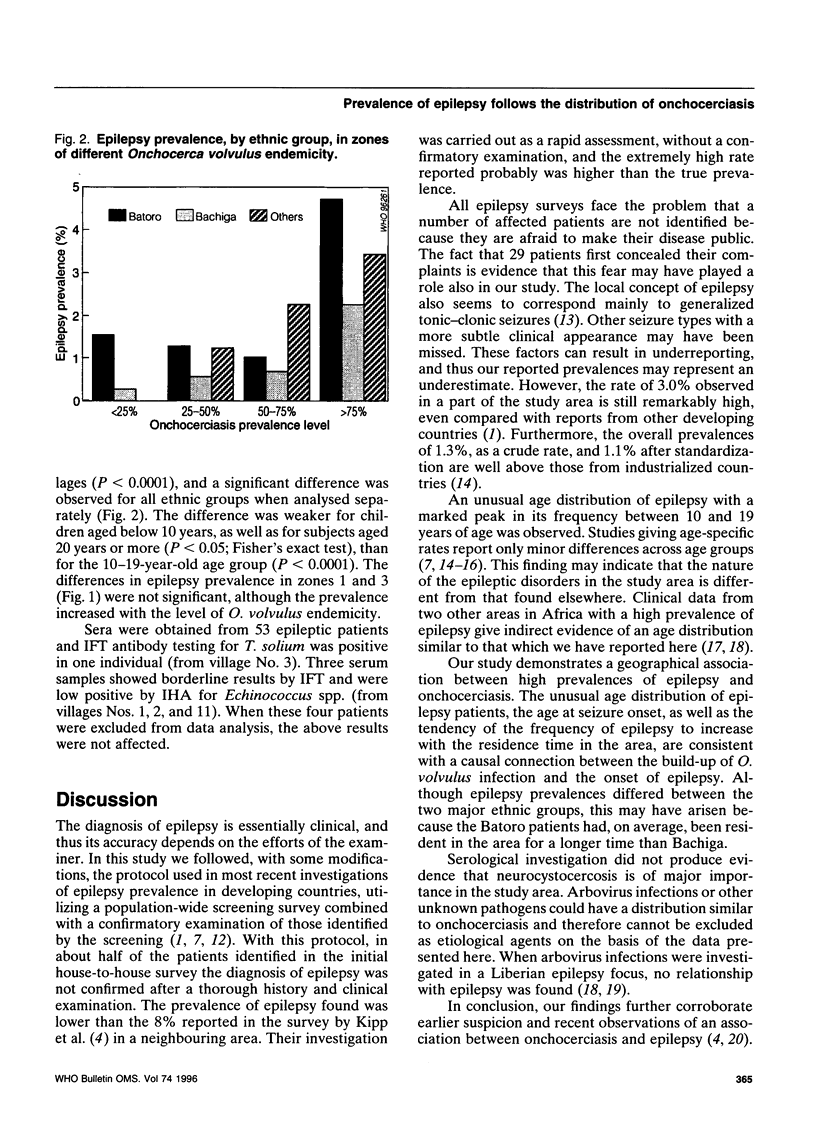Abstract
Epidemiological surveys indicate that the prevalence of epilepsy is higher in developing countries than in industrialized countries. Except for neurocystocercosis due to Taenia solium, little is known about possible underlying causes. This article reports the relationship between epilepsy and onchocerciasis in an Onchocerca volvulus endemic area in West Uganda. Individuals complaining of seizures were identified by means of a population census in 12 villages. Active epilepsy was confirmed in 61 of 4743 inhabitants (crude prevalence rate = 1.3%; age-standardized rate = 1.1%). Distribution of epilepsy in the study area was clustered, ranging from a prevalence of 0.2% to 3.4% in different villages. Age-specific prevalence was highest between 10 and 19 years, with a rate of 3.6% for the study are as a whole, and up to 10.0% in villages of high epilepsy prevalence. The prevalence of onchocerciasis in the 10-19-year-old age group was assessed by skin-snip biopsy and ranged from 15% to 85% in different villages. Epilepsy was significantly more frequent in the three villages with the highest levels of O. volvulus endemicity than in other villages (P < 0.0001). Serological testing for T. solium infection was positive in one and borderline in three of 53 epilepsy patients tested. The significant correlation between epilepsy and onchocerciasis did not change when these four patients were excluded from the analysis. These findings suggest a strong association between epilepsy and onchocerciasis in this area. This could have significant implications for the concept of morbidity due to O. volvulus.
Full text
PDF






Selected References
These references are in PubMed. This may not be the complete list of references from this article.
- Attia-Romdhane N., Mrabet A., Ben Hamida M. Prevalence of epilepsy in Kelibia, Tunisia. Epilepsia. 1993 Nov-Dec;34(6):1028–1032. doi: 10.1111/j.1528-1157.1993.tb02129.x. [DOI] [PubMed] [Google Scholar]
- Cowan L. D., Bodensteiner J. B., Leviton A., Doherty L. Prevalence of the epilepsies in children and adolescents. Epilepsia. 1989 Jan-Feb;30(1):94–106. doi: 10.1111/j.1528-1157.1989.tb05289.x. [DOI] [PubMed] [Google Scholar]
- Fischer P., Kipp W., Bamuhiga J., Binta-Kahwa J., Kiefer A., Büttner D. W. Parasitological and clinical characterization of Simulium neavei-transmitted onchocerciasis in western Uganda. Trop Med Parasitol. 1993 Dec;44(4):311–321. [PubMed] [Google Scholar]
- Hauser W. A., Kurland L. T. The epidemiology of epilepsy in Rochester, Minnesota, 1935 through 1967. Epilepsia. 1975 Mar;16(1):1–66. doi: 10.1111/j.1528-1157.1975.tb04721.x. [DOI] [PubMed] [Google Scholar]
- Jilek-Aall L., Jilek W., Miller J. R. Clinical and genetic aspects of seizure disorders prevalent in an isolated African population. Epilepsia. 1979 Dec;20(6):613–622. doi: 10.1111/j.1528-1157.1979.tb04845.x. [DOI] [PubMed] [Google Scholar]
- Kilian A. H. Onchocerciasis and epilepsy. Lancet. 1994 Apr 16;343(8903):983–983. doi: 10.1016/s0140-6736(94)90110-4. [DOI] [PubMed] [Google Scholar]
- Kipp W., Kasoro S., Burnham G. Onchocerciasis and epilepsy in Uganda. Lancet. 1994 Jan 15;343(8890):183–184. doi: 10.1016/s0140-6736(94)90980-6. [DOI] [PubMed] [Google Scholar]
- Osuntokun B. O., Adeuja A. O., Nottidge V. A., Bademosi O., Olumide A., Ige O., Yaria F., Bolis C. L., Schoenberg B. S. Prevalence of the epilepsies in Nigerian Africans: a community-based study. Epilepsia. 1987 May-Jun;28(3):272–279. doi: 10.1111/j.1528-1157.1987.tb04218.x. [DOI] [PubMed] [Google Scholar]
- Ovuga E., Kipp W., Mungherera M., Kasoro S. Epilepsy and retarded growth in a hyperendemic focus of onchocerciasis in rural western Uganda. East Afr Med J. 1992 Oct;69(10):554–556. [PubMed] [Google Scholar]
- Senanayake N., Román G. C. Epidemiology of epilepsy in developing countries. Bull World Health Organ. 1993;71(2):247–258. [PMC free article] [PubMed] [Google Scholar]
- Shorvon S. D., Farmer P. J. Epilepsy in developing countries: a review of epidemiological, sociocultural, and treatment aspects. Epilepsia. 1988;29 (Suppl 1):S36–S54. doi: 10.1111/j.1528-1157.1988.tb05790.x. [DOI] [PubMed] [Google Scholar]
- Van der Waals F. W., Asher D. M., Goudsmit J., Pomeroy K. L., Karabatsos N., Gajdusek D. C. Post-encephalitic epilepsy and arbovirus infections in an isolated rainforest area of central Liberia. Trop Geogr Med. 1986 Sep;38(3):203–208. [PubMed] [Google Scholar]


